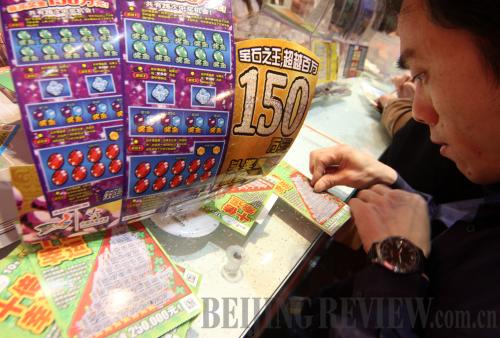|
 |
|
SCRATCH-N-WIN: China's lottery sales reached a record high of 221.4 billion yuan ($35.14 billion) in 2011 (CFP) |
A young man wearing a panda mask walks onto a stage and collects a check for 565 million yuan ($89.70 million). It sounds like the beginning of some improbable Hollywood situation comedy, but actually the man from east China's Zhejiang Province was collecting his lottery winnings, the largest jackpot in the country's history, on August 29, 2011. He withheld his name and wore a mask to protect his identity from those who might be tempted to take advantage of his sudden windfall.
Although he refused to disclose his name, the lucky winner did donate 20 million yuan ($3.18 million) to charity projects for the elderly and children. An income tax of 109 million yuan ($17.30 million) was also levied on his winnings.
Last year, 1,652 different lotteries in China offered jackpot prizes of more than 5 million yuan ($794,092) each. Four lotteries offered prizes in excess of 100 million yuan ($15.88 million).
While games of chance in China were banned in 1949, the lottery industry has recorded a robust rebound since it was reintroduced in 1987, making China the fastest-growing lottery market in the world. Over a quarter of century, China's annual lottery revenue has risen from almost nothing to more than 200 billion yuan ($35.16 billion). According to statistics from the World Lottery Association, global lottery sales worldwide recorded a year-on-year growth of 6.3 percent in 2010, while the growth rate in China was a staggering 25.5 percent.
In 2011, China's lottery sales hit a record 221.5 billion yuan ($35.16 billion), up 33.2 percent year on year, only four years after sales topped the 100-billion-yuan ($15.88-billion) benchmark in 2007.
Although China's lottery revenue was still smaller than that of some developed countries, its overall lottery market was highly developed. China's Lottery Development Index, the ratio of a country's annual lottery revenue against its GDP, has stood at around 0.4 percent since 2005, on par with that of the United States.
There are two categories of state-operated lotteries in China—welfare lotteries and sports lotteries. The money raised from draws has become an important source of funding for government social welfare and sports programs.
The revenue structure of most lotteries in China is that 50 percent of takings are paid out as prizes, 35 percent go to a social welfare or sports fund and no more than 15 percent goes to lottery operators. In 2011 alone, lotteries raised a total of 63.4 billion yuan ($10.07 billion) for public welfare and sports funds.
In order to stamp out fraud in the fast-growing lottery industry and ensure its credibility, China introduced its first administrative regulations governing lotteries, the Regulations on Administration of Lotteries, on July 1, 2009. The regulations clarify issues about the administration of lotteries, the issuing of licenses to run lotteries, sales, draws and prize collection, lottery fund management as well as the penalties with respect to breach of regulations.
In October 2010, the Ministry of Finance issued two regulations on the administration of online and telephone lottery sales.
According to the Ministry of Finance, the latest Detailed Rules of Regulations on the Administration of Lotteries, which took effect on March 1, are intended to further regulate China's lottery market, safeguard the interests of players and enhance lotteries' credibility. For example, according to the new rules, the original records of lottery sales should be kept for at least 60 months after sales.
The rules also barred any person working for lottery issuers, sellers and retailers from compelling lottery winners to donate all or part of their prize money.
| 